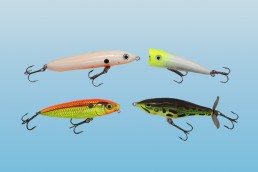Alternative Tactics for Spring River Smallmouths
SHARE THIS POST
When water temperatures are still in the 50s, Andrew Ragas uses crankbaits and topwaters as his primary ‘fish-finders’ for river smallmouths.
Rivers provide different opportunities than lakes for both seasonal movement and presentation options. In short, they often require different adaptations than are required when fishing for smallmouth bass in spring. Here are some good examples:
The strike zone
The strike zone is larger and wider on river fisheries compared to that in lake fisheries. Always on the move, river smallmouths readily chase and fly in for baits—if they’re seen.
Environmental conditions have a dramatic influence on fish behavior and feeding habits. On river systems, warming water temperatures, and the stability of current and water clarity, are two of the most important factors in shaping the strike zone.
Good anglers experiment with size, speed, color and action of baits to match the fish’s present feeding mood. In spring, we often like to cover water and fish with baits that provide a lot of hang time. This enables smallmouths to effectively catch up to it and strike—at least the specimens who are committed to feeding.
Suspending jerkbaits and weightless Texas-rigged, fluke-style minnows are two of my all-time favorites for river smallmouths. The latter is the better option due to avoiding snags, and its abilities to cleanly fish through all types of cover and river obstructions.
In river systems, the fluke minnow evolves into a glide bait. The push and glide from current will do most of the work for you.
Crankbaits rule
When water temperatures are still in the 50s, smallmouths will pursue lures with considerable interest. Crankbaits are my fish-finders.
Crankbaits in craw pattern are deadly in these spring schooling and staging situations. On river holes, shallow divers such as rusty crawdad Rapala DT 4s are best with a medium-steady retrieve. Balsa isn’t the most durable crankbait body material for river fishing and will not hold-up to the abuse from rocks and boulders, but it’s the most effective.
Likewise, squarebill crankbaits in craw patterns (whichever brand you prefer) also generate considerable fish interest.
Cast crankbaits upstream and horizontally through holes. As your bait dives deep into undercurrent benthic zones, and bang away at the terrain of the hard bottom, you’ll potentially catch several staging fish holed up together.
Are you enjoying this post?
You can be among the first to get the latest info on where to go, what to use and how to use it!
On any river system, you will catch the most active fish with crankbaits, first. Bites will come quickly, but often dissipate as fish grow conditioned. After one flurry of bites comes and goes, another window might soon take place again a few hours later.
Rod and reel choice is an important player in these fisheries. Hooksets are near-automatic in current with my medium-moderate St. Croix Legend Glass (LGC72MM). Its S-Glass construction aided with no-stretch 10-pound fluorocarbon line are my tools for the trade.
It’s never too early to throw a topwater
Topwaters are understandably neglected and underutilized during the cold-water seasons. River systems and their fisheries are different animals than lakes. On shallower systems, topwaters patiently worked slowly across current breaks will produce in early spring. It’s overlooked.
“Most guys will never work a topwater at this time,” says Wisconsin River guide Kurt Schultz. Every season, some of Schultz’s biggest fish are enticed by topwaters worked slower and more methodically when water temperatures are still in the 40s.
We’ve done particularly well with Rapala X-Rap Pops. Popper style baits that allow for pauses and breaks in between are recommended. Remember, the colder the water, the longer the pause. It’s a deadly tactic through near-shore eddies and quiet, slack-water pools.
Each river system has its own personality, intricacies and functions in how its fish species use the system. Not every river behaves the same. No matter the river system, the most important lesson I can give is that river smallmouths are always on the move. They never hold to structure and spots like lake fish do. And every day on flowing waters is a different story, inviting new strategies.
Schultz admits that if you are new to river smallmouths, your first few outings may be trying times. “Every minute you spend on the river, whether catching bass or simply navigating it, you should be learning things,” he says. What sets Schultz apart from most river anglers is his ability to process information, and retain the knowledge learned from over 20 years of river fishing experience. “I have become a great river angler because of all the times I’ve spent on this water, catching nothing,” he says. When Schultz catches fish, he analyzes how it was caught, and why it struck his lure. It enables him to figure out their patterns and find their locations.
Rivers are my favorite destinations in spring. I’m confident these insights will help shape and influence the ways and strategies in which you approach them for smallmouths. too.
See Andrew Ragas in Action…
Andrew Ragas will also be presenting tips on using Lowrance electronics on an upcoming episode of MidWest Outdoors television, airing in April. Check local listings or catch it on the MidWest Outdoors YouTube channel soon after it airs on TV.
You’ll find plenty of helpful spring fishing tips in the April and May issues of MidWest Outdoors. Subscribe on our website.
MWO
SHARE THIS POST
You may also like...
Nothing found.
Did you enjoy this post?
You can be among the first to get the latest info on where to go, what to use and how to use it!
Andrew Ragas
Andrew Ragas splits time between Chicago and Wisconsin’s Northwoods. Based in Minocqua, Wis., he specializes in trophy bass fishing and offers guided trips from May through October. While big bass are his passion, he dabbles in multispecies, as well. He may be visited online at northwoodsbass.com
